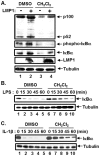Lupeol is one of active components in the extract of Chrysanthemum indicum Linne that inhibits LMP1-induced NF-κB activation
- PMID: 24303085
- PMCID: PMC3841202
- DOI: 10.1371/journal.pone.0082688
Lupeol is one of active components in the extract of Chrysanthemum indicum Linne that inhibits LMP1-induced NF-κB activation
Abstract
We have previously reported that seventy percent ethanol extract of Chrysanthemum indicum Linne (CIE) strongly reduces Epstein-Barr virus (EBV)-transformed lymphoblastoid cell line (LCL) survival by inhibiting virus-encoded latent infection membrane protein 1 (LMP1)-induced NF-κB activation. To identify an active compound(s) in CIE that inhibits LMP1-induced NF-κB activation, activity-guided fractionation was employed. The CH2Cl2 fraction of CIE strongly reduced LMP1-induced NF-κB activation and LCL viability with relatively low cytotoxic effects on primary human foreskin fibroblast (HFF), HeLa or Burkitt's lymphoma (BL41) cells. Furthermore, lupeol, a pentacyclic triterpene, was identified in the CH2Cl2 fraction of CIE to attenuate LMP1-induced NF-κB activation and LCL viability. This study demonstrates that lupeol is one of active compounds in the CH2Cl2 fraction of CIE that inhibits LMP1-induced NF-κB activation and reduces NF-κB-dependent LCL viability.
Conflict of interest statement
Figures










Similar articles
-
The extract of Chrysanthemum indicum Linne inhibits EBV LMP1-induced NF-κB activation and the viability of EBV-transformed lymphoblastoid cell lines.Food Chem Toxicol. 2012 May;50(5):1524-8. doi: 10.1016/j.fct.2012.02.034. Epub 2012 Feb 24. Food Chem Toxicol. 2012. PMID: 22387267
-
The oncogenic protein kinase Tpl-2/Cot contributes to Epstein-Barr virus-encoded latent infection membrane protein 1-induced NF-kappaB signaling downstream of TRAF2.J Virol. 2002 May;76(9):4567-79. doi: 10.1128/jvi.76.9.4567-4579.2002. J Virol. 2002. PMID: 11932422 Free PMC article.
-
Chrysanthemum indicum Linné extract inhibits the inflammatory response by suppressing NF-kappaB and MAPKs activation in lipopolysaccharide-induced RAW 264.7 macrophages.J Ethnopharmacol. 2009 Apr 21;122(3):473-7. doi: 10.1016/j.jep.2009.01.034. Epub 2009 Feb 3. J Ethnopharmacol. 2009. PMID: 19429315
-
LMP1 signaling and activation of NF-kappaB in LMP1 transgenic mice.Oncogene. 2006 Jan 12;25(2):288-97. doi: 10.1038/sj.onc.1209023. Oncogene. 2006. PMID: 16247482
-
NF-κB and IRF7 pathway activation by Epstein-Barr virus Latent Membrane Protein 1.Viruses. 2013 Jun 21;5(6):1587-606. doi: 10.3390/v5061587. Viruses. 2013. PMID: 23793113 Free PMC article. Review.
Cited by
-
Effects of Lupenone, Lupeol, and Taraxerol Derived from Adenophora triphylla on the Gene Expression and Production of Airway MUC5AC Mucin.Tuberc Respir Dis (Seoul). 2015 Jul;78(3):210-7. doi: 10.4046/trd.2015.78.3.210. Epub 2015 Jun 30. Tuberc Respir Dis (Seoul). 2015. PMID: 26175774 Free PMC article.
-
Immunomodulatory properties of triterpenes.Phytochem Rev. 2022;21(2):537-563. doi: 10.1007/s11101-021-09785-x. Epub 2021 Nov 18. Phytochem Rev. 2022. PMID: 34812259 Free PMC article. Review.
-
Ethyl Acetate Fraction of Adenophora triphylla var. japonica Inhibits Migration of Lewis Lung Carcinoma Cells by Suppressing Macrophage Polarization toward an M2 Phenotype.J Pharmacopuncture. 2019 Dec;22(4):253-259. doi: 10.3831/KPI.2019.22.034. Epub 2019 Dec 31. J Pharmacopuncture. 2019. PMID: 31970023 Free PMC article.
-
SARS-CoV-2 Nonstructural Proteins 1 and 13 Suppress Caspase-1 and the NLRP3 Inflammasome Activation.Microorganisms. 2021 Feb 26;9(3):494. doi: 10.3390/microorganisms9030494. Microorganisms. 2021. PMID: 33652815 Free PMC article.
-
Exploring the antimicrobial, anti-inflammatory, antioxidant, and immunomodulatory properties of Chrysanthemum morifolium and Chrysanthemum indicum: a narrow review.Front Pharmacol. 2025 Mar 19;16:1538311. doi: 10.3389/fphar.2025.1538311. eCollection 2025. Front Pharmacol. 2025. PMID: 40176916 Free PMC article. Review.
References
Publication types
MeSH terms
Substances
LinkOut - more resources
Full Text Sources
Other Literature Sources
Research Materials
Miscellaneous

